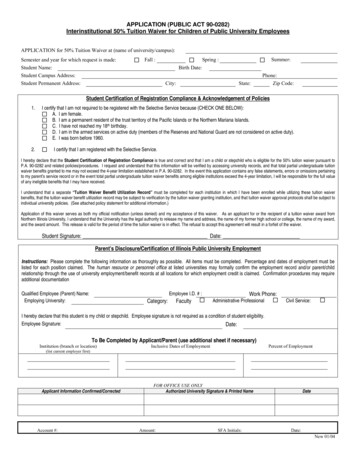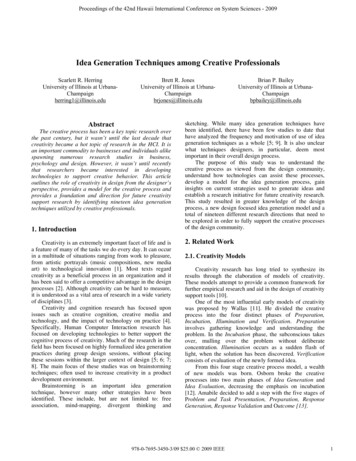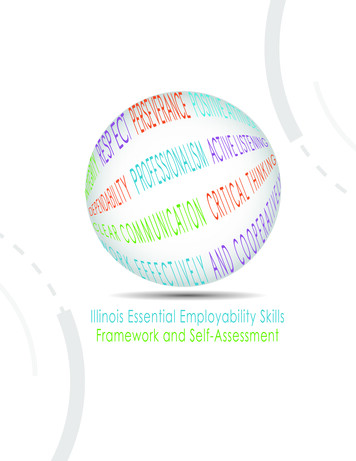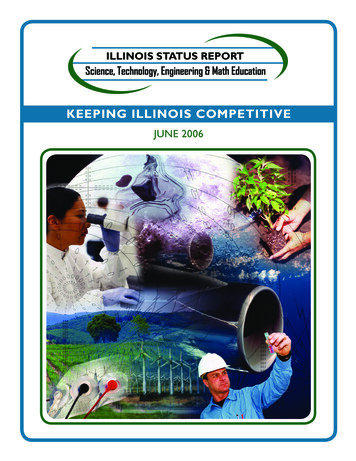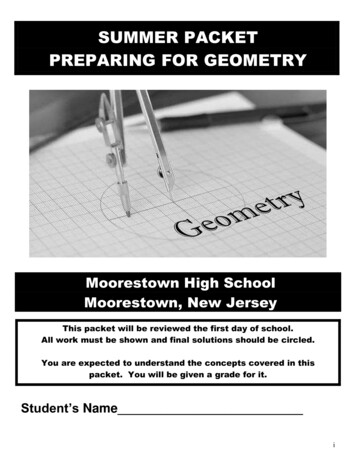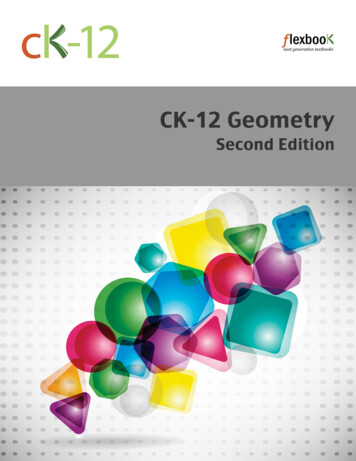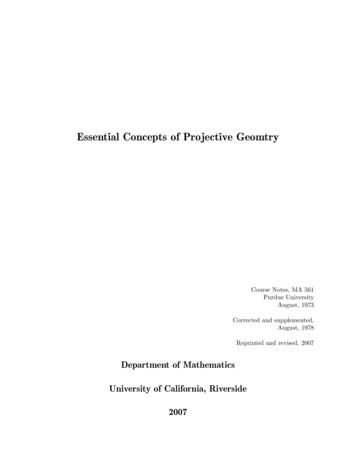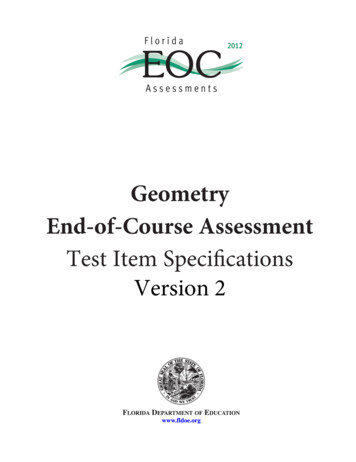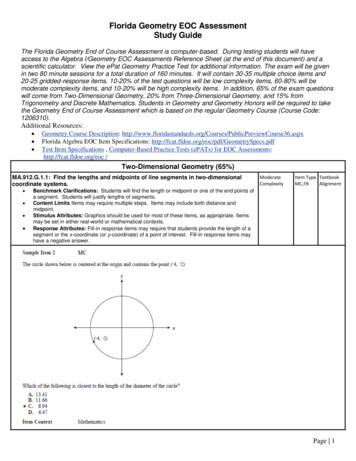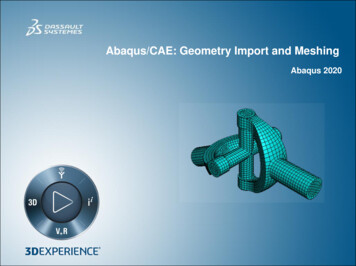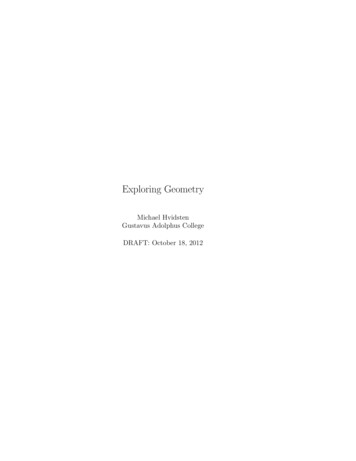
Transcription
Exploring GeometryMichael HvidstenGustavus Adolphus CollegeDRAFT: October 18, 2012
iiCopyright @ 2004 by Michael HvidstenRevised draft, August 2012.All rights reserved. No part of this publication may be reproduced,stored, or transmitted without prior consent of the author.
ContentsPrefaceixAcknowledgmentsxiii1 Geometry and the Axiomatic Method1.1 Early Origins of Geometry . . . . . . . . .1.2 Thales and Pythagoras . . . . . . . . . . .1.2.1 Thales . . . . . . . . . . . . . . . .1.2.2 Pythagoras . . . . . . . . . . . . .1.3 Project 1 - The Ratio Made of Gold . . .1.3.1 Golden Section . . . . . . . . . . .1.3.2 Golden Rectangles . . . . . . . . .1.4 The Rise of the Axiomatic Method . . . .1.5 Properties of Axiomatic Systems . . . . .1.5.1 Consistency . . . . . . . . . . . . .1.5.2 Independence . . . . . . . . . . . .1.5.3 Completeness . . . . . . . . . . . .1.5.4 Gödel’s Incompleteness Theorem .1.6 Euclid’s Axiomatic Geometry . . . . . . .1.6.1 Euclid’s Postulates . . . . . . . . .1.7 Project 2 - A Concrete Axiomatic System2 Euclidean Geometry2.1 Angles, Lines, and Parallels . . . . . . .2.2 Congruent Triangles and Pasch’s Axiom2.3 Project 3 - Special Points of a Triangle .2.3.1 Circumcenter . . . . . . . . . . .2.3.2 Orthocenter . . . . . . . . . . . .2.3.3 Incenter . . . . . . . . . . . . . .iii.114678914182627282930333440.51526368687073
ivCONTENTS2.4. 74. 75. 78. 80. 87. 89. 98. 1033 Analytic Geometry3.1 The Cartesian Coordinate System . . . . . . . . . . . . . .3.2 Vector Geometry . . . . . . . . . . . . . . . . . . . . . . . .3.3 Project 5 - Bézier Curves . . . . . . . . . . . . . . . . . . .3.4 Angles in Coordinate Geometry . . . . . . . . . . . . . . . .3.5 The Complex Plane . . . . . . . . . . . . . . . . . . . . . .3.5.1 Polar Form . . . . . . . . . . . . . . . . . . . . . . .3.5.2 Complex Functions . . . . . . . . . . . . . . . . . . .3.5.3 Analytic Functions and Conformal Maps (Optional)3.6 Birkhoff’s Axiomatic System . . . . . . . . . . . . . . . . .107. 109. 112. 117. 124. 130. 131. 133. 136. 1404 Constructions4.1 Euclidean Constructions . . . . . . .4.2 Project 6 - Euclidean Eggs . . . . . .4.3 Constructibility . . . . . . . . . . . .4.4 Mini-Project - Origami Construction2.52.62.7Measurement and Area . . . . . . . . . . . . . . .2.4.1 Mini-Project - Area in Euclidean Geometry2.4.2 Cevians and Areas . . . . . . . . . . . . . .Similar Triangles . . . . . . . . . . . . . . . . . . .2.5.1 Mini-Project - Finding Heights . . . . . . .Circle Geometry . . . . . . . . . . . . . . . . . . .Project 4 - Circle Inversion . . . . . . . . . . . . .2.7.1 Orthogonal Circles Redux . . . . . . . . . .1471471591631735 Transformational Geometry5.1 Euclidean Isometries . . . . . . . . . . . . . . . . . .5.2 Reflections . . . . . . . . . . . . . . . . . . . . . . . .5.2.1 Mini-Project - Isometries through Reflection5.2.2 Reflection and Symmetry . . . . . . . . . . .5.3 Translations . . . . . . . . . . . . . . . . . . . . . . .5.3.1 Translational Symmetry . . . . . . . . . . . .5.4 Rotations . . . . . . . . . . . . . . . . . . . . . . . .5.4.1 Rotational Symmetry . . . . . . . . . . . . .5.5 Project 7 - Quilts and Transformations . . . . . . . .5.6 Glide Reflections . . . . . . . . . . . . . . . . . . . .5.6.1 Glide Reflection Symmetry . . . . . . . . . .5.7 Structure and Representation of Isometries . . . . .5.7.1 Matrix Form of Isometries . . . . . . . . . . .181182187189190193196199203206212215217218.
CONTENTS5.8v5.7.2 Compositions of Rotations and Translations . . . .5.7.3 Compositions of Reflections and Glide Reflections5.7.4 Isometries in Computer Graphics . . . . . . . . . .5.7.5 Summary of Isometry Compositions . . . . . . . .Project 8 - Constructing Compositions . . . . . . . . . . .6 Symmetry6.1 Finite Plane Symmetry Groups . . . . . .6.2 Frieze Groups . . . . . . . . . . . . . . . .6.3 Wallpaper Groups . . . . . . . . . . . . .6.4 Tiling the Plane . . . . . . . . . . . . . .6.4.1 Escher . . . . . . . . . . . . . . . .6.4.2 Regular Tessellations of the Plane6.5 Project 9 - Constructing Tessellations . .7 Non-Euclidean Geometry7.1 Background and History . . . . . . . . . .7.2 Models of Hyperbolic Geometry . . . . . .7.2.1 Poincaré Model . . . . . . . . . . .7.2.2 Mini-Project - The Klein Model .7.3 Basic Results in Hyperbolic Geometry . .7.3.1 Parallels in Hyperbolic Geometry .7.3.2 Omega Points and Triangles . . . .7.4 Project 10 - The Saccheri Quadrilateral .7.5 Lambert Quadrilaterals and Triangles . .7.5.1 Lambert Quadrilaterals . . . . . .7.5.2 Triangles in Hyperbolic Geometry7.6 Area in Hyperbolic Geometry . . . . . . .7.7 Project 11 - Tiling the Hyperbolic Plane .7.8 Models and Isomorphism . . . . . . . . .221223224225227.233. 235. 239. 244. 254. 254. 256. 259.263. 263. 266. 266. 271. 275. 276. 281. 286. 290. 290. 293. 297. 301. 3068 Non-Euclidean Transformations8.1 Möbius Transformations . . . . . . . . . . . . . . . . . .8.1.1 Fixed Points and the Cross Ratio . . . . . . . . .8.1.2 Geometric Properties of Möbius Transformations8.2 Isometries in the Poincaré Model . . . . . . . . . . . . .8.3 Isometries in the Klein Model . . . . . . . . . . . . . . .8.4 Mini-Project - The Upper Half-Plane Model . . . . . . .8.5 Weierstrass Model . . . . . . . . . . . . . . . . . . . . .8.6 Hyperbolic Calculation . . . . . . . . . . . . . . . . . . .313317317319322327330333333
viCONTENTS.3343363373383403429 Fractal Geometry9.1 The Search for a “Natural” Geometry . . . . .9.2 Self-Similarity . . . . . . . . . . . . . . . . . . .9.2.1 Sierpinski’s Triangle . . . . . . . . . . .9.2.2 Cantor Set . . . . . . . . . . . . . . . .9.3 Similarity Dimension . . . . . . . . . . . . . . .9.4 Project 13 - An Endlessly Beautiful Snowflake .9.5 Contraction Mappings . . . . . . . . . . . . . .9.6 Fractal Dimension . . . . . . . . . . . . . . . .9.7 Project 14 - IFS Ferns . . . . . . . . . . . . . .9.8 Algorithmic Geometry . . . . . . . . . . . . . .9.8.1 Turtle Geometry . . . . . . . . . . . . .9.9 Grammars and Productions . . . . . . . . . . .9.9.1 Space-filling Curves . . . . . . . . . . .9.10 Project 15 - Words into Plants . . . . . . . . .347347349349352353356362372375385385388389394A Book I of Euclid’s ElementsA.1 Definitions . . . . . . . . . .A.2 The Postulates (Axioms) . .A.3 Common Notions . . . . . .A.4 Propositions (Theorems) . .8.78.6.1 Arclength of Parameterized Curves8.6.2 Geodesics . . . . . . . . . . . . . .8.6.3 The Angle of Parallelism . . . . . .8.6.4 Right Triangles . . . . . . . . . . .8.6.5 Area . . . . . . . . . . . . . . . . .Project 12 - Infinite Real Estate? . . . . .401401403403403B Brief Guide to Geometry ExplorerB.1 The Main Geometry Explorer WindowB.2 Selecting Objects . . . . . . . . . . . .B.3 Active vs. Inactive Tools . . . . . . . .B.4 Labels . . . . . . . . . . . . . . . . . .B.5 Object Coloring . . . . . . . . . . . . .B.6 Online Help . . . . . . . . . . . . . . .B.7 Undo/Redo of Actions . . . . . . . . .B.8 Clearing and Resizing the Canvas . . .B.9 Saving Files as Images . . . . . . . . .B.10 Main Window Button Panels . . . . .411412414417417418419419420421422.
CONTENTSB.11B.12B.13B.14B.15B.16B.10.1 Create Panel . . . . . . . . . .B.10.2 Construct Panel . . . . . . . .B.10.3 Transform Panel . . . . . . . .Measurement in Geometry Explorer . .B.11.1 Neutral Measurements . . . . .B.11.2 Euclidean-only Measurements .B.11.3 Hyperbolic-only MeasurementsB.11.4 User Input Measurements . . .Using Tables . . . . . . . . . . . . . .Using the Calculator . . . . . . . . . .Hyperbolic Geometry . . . . . . . . .Analytic Geometry . . . . . . . . . . .Turtle Geometry . . . . . . . . . . . .vii.422422426430431432433433433434435437437C Birkhoff ’s Axioms443D Hilbert’s Axioms445E The 17 Wallpaper Groups447Bibliography453Index457
PrefaceIt may well be doubted whether, in all the range of science,there is any field so fascinating to the explorer, so rich in hiddentreasures, so fruitful in delightful surprises, as Pure Mathematics.—Lewis Carroll (Charles Dodgson), 1832–1898An explorer is one who seeks out new worlds and ideas. As Lewis Carrollwould probably agree, exploration is not always easy—the explorer can attimes find the going tough. But, the treasures and surprises that activeexploration of ideas brings is worth the effort.Geometry is one of the richest areas for mathematical exploration. Thevisual aspects of the subject make exploration and experimentation naturaland intuitive. At the same time, the abstractions developed to explaingeometric patterns and connections make the subject extremely powerfuland applicable to a wide variety of physical situations. In this book we giveequal weight to intuitive and imaginative exploration of geometry as well asto abstract reasoning and proofs.As any good school teacher knows, intuition is developed through play,the sometimes whimsical following of ideas and notions without clear goalsin mind. To encourage a playful appreciation of geometric ideas, we haveincorporated many computer explorations in the text. The software usedin these explorations is Geometry Explorer, a virtual geometry laboratorywhere one can create geometric objects (like points, circles, polygons, areas,etc.), carry out transformations on these objects (dilations, reflections, rotations, and translations), and measure aspects of these objects (like length,area, radius, etc.). As such, it is much like doing geometry on paper (orsand) with a ruler and compass. However, on paper such constructions arestatic—points placed on the paper can never be moved again. In GeometryExplorer, all constructions are dynamic. One can draw a segment and thengrab one of the endpoints and move it around the canvas, with the segmentmoving accordingly. Thus, one can construct a geometric figure and test outix
xPREFACEhypotheses by experimentation with the construction.The development of intuitive notions of geometric concepts is a criticalfirst step in understanding such concepts. However, intuition alone cannotprovide the basis for precise calculation and analysis of geometric quantities.For example, one may know experimentally that the sides of a right trianglefollow the Pythagorean Theorem, but data alone do not show why this resultis true. Only a logical proof of a result will give us confidence in using it inany given situation.Throughout this text there is a dual focus on intuition/experimentationon the one hand and on explanation/proofs on the other. This integrationof exploration and explanation can be seen most clearly in the use of majorprojects to tie together concepts in each chapter. For example, the firstproject explores the golden ratio and its amazing and ubiquitous properties.Students not only experimentally discover the properties of the golden ratio,but are asked to dig deeper and analyze why these properties are true.The goal of the projects is to have students actively explore geometrythrough a three-fold approach. Students will first see a topic introduced inthe text. Then, they will explore that topic using Geometry Explorer or bymeans of in-class group projects. Finally, they will review and report ontheir exploration, discussing what was discovered, conjectured, and provedduring the course of the project.The beginning of each project is designated by a special heading—theproject title set between two horizontal lines. The conclusion of each projectis designated by an ending horizontal line. Projects are illustrated withscreen shots from the Geometry Explorer program, which comes bundledwith the text.Using Geometry ExplorerEach project includes a series of specific geometric activities using GeometryExplorer. The following conventions will be used for directing computerexplorations: Menu References All menu references will be in bold face typeand will reference the menu option to click on. Parent menus will belisted in parentheses to assist in navigating to the correct menu. Forexample, the phrase “Click on Hide (View menu)” means to go tothe Hide menu under the View menu and select that menu.
xi Selection When asked to select an object on the screen, first checkthat the Select button (the one with the left arrow in the Create panelof buttons) is pressed, and then click on the object to select it. Multi-selection To select more than one object, hold down the Shiftkey when selecting. Creating Objects When asked to create an object on the screen,use one of the buttons in the Create panel. To create a point, forexample, first click on the Point button in the Create panel and thenclick on the screen. To create a circle, click on the Circle button andclick and drag to create a circle. Constructing Objects When asked to construct an object, use oneof the buttons in the Construct panel. These buttons will work onlyif the correct objects for the construction have already been selected.For example, to construct the intersection of two circles, first multiselect the circles and then click on the Intersect button (first buttonin first row of Construct panel of buttons). Dragging or Moving Objects To move an object, use the Selecttool. Click on the object and drag the mouse to move the object. Attaching Points to Objects When asked to attach a point to anobject such as a circle, create a point on top of a portion of the circle.To test whether a point is attached to an object like a circle, drag thepoint with the mouse. The point should move only along the circle;that is, it is attached to the circle.Keeping these few conventions in mind will solve many, if not most, ofthe user interaction issues that come up when doing the projects of thetext. A more complete reference guide to Geometry Explorer can be foundin Appendix B.AudienceThis text is designed for use by mathematics students at the junior or seniorcollegiate level. The background in geometry required is that of elementaryhigh school Euclidean geometry. Prior experience with proving mathematical results is highly recommended. Some experience with matrix algebraand the notion of group from abstract algebra is also highly desirable.
xiiPREFACEThe arrangement of topics in the text was designed to give as muchflexibility as possible. While Chapters 1 and 2 are fundamental, many of theother chapters can be covered independently from one another. Chapter 3covers basic analytic geometry of vectors and angles, as well as complexnumbers and analytic functions. Unless review of such matters is necessary,Chapter 3 can be viewed as optional foundational material.Chapter 4 covers Euclidean constructions and depends only on the material in Chapters 1 and 2. Chapter 5 is devoted to transformational geometryand requires only a basic understanding of vectors and angles from Chapter 3, beyond the material covered in Chapters 1 and 2. Chapter 5 is apre-requisite for all subsequent chapters. Chapters 6, 7, and 9 can be covered in any order. Chapter 7 is a pre-requisite for Chapter 8.A suggested syllabus for a one-semester course for prospective highschool geometry teachers would include Chapters 1, 2, 4, sections 5.1–5.6,sections 7.1–7.6, and as much of the first four sections of Chapter 9 as timepermits.A suggested syllabus for a one-semester course for math majors of betterthan average ability would include Chapters 1, 2, 5, 6, 7, and 9.A suggested syllabus for a one-semester course focusing on non-Euclideangeometry would include Chapters 1, 2, and section 3.5, as well as Chapters 5,7, and as much of Chapter 8 as time permits.Technical RequirementsThe software that accompanies this book, Geometry Explorer, runs on Macintosh, Windows, and Linux computers, and also on any other computerthat has a Java Virtual Machine (Java 1.2 or above). At least 128 MB ofRAM is needed for the program to effectively function. On Macintosh computers the operating system must be 9.0 or above. On PCs the operatingsystem must be at least at the level of Windows 98/NT. For an acceptablelevel of performance, Geometry Explorer should be installed on computersthat have clock speeds of at least 200 MHz. To install the software, followthe instructions on the Installation Guide that comes with the software CD.For software updates and bug fixes, check the Geometry Explorer web sitehttp://www.gac.edu/ hvidsten/gex.
AcknowledgmentsThis text and the accompanying Geometry Explorer software have evolvedfrom the many geometry courses I have taught at Gustavus Adolphus College. I am deeply grateful to my students, who have graciously allowedme to experiment with different strategies in discovery-based learning andthe integration of technology into the classroom. Their encouragement andexcitement over these new approaches have been the primary motivatingfactors for writing an integrated learning environment for the active exploration of geometry.I am especially grateful to those who helped out in the early phases ofthis project. Alicia Sutphen, a former student, provided valuable assistancein the early stages of designing the software. Special thanks go to those faculty who field-tested early drafts of the text: Steve Benzel, Berry College;Jason Douma, University of Sioux Falls; George Francis, University of Illinois at Urbana-Champaign; Dan Kemp, South Dakota State University; BillStegemoller, University of Southern Indiana; Mary Wiest, Minnesota StateUniversity at Mankato; and Stephen Walk, St. Cloud State University.I greatly appreciate the hard work of my editors at McGraw-Hill, DanSeibert and Bob Ross. The quality of the text was greatly improved throughthe assistance of Paul Anagnostopoulos of Windfall Software and MaryEllenOliver of Planet Cat Books.I would also like to thank the following reviewers: Nick Anghel, University of North Texas; Brian Beaudrie, Northern Arizona University; DavidBoyd, Valdosta State University; Anita Burris, Youngstown State University; Victor Cifarelli, University of North Carolina at Charlotte; MichaelDorff, Brigham Young University; Gina Foletta, Northern Kentucky University; Matthew Jones, California State University–Dominguez Hills; TabithaMingus, Western Michigan University; Chris Monico, Texas Tech University; F. Alexander Norman, University of Texas at San Antonio; FerdinandRivera, San Jose State University; Craig Roberts, Southeast Missouri StateUniversity; Philippe Rukimbira, Florida International University; Don Ryoti, Eastern Kentucky University; Sherrie Serros, Western Kentucky Unixiii
xivACKNOWLEDGMENTSversity; Wendy Hageman Smith, Radford University;The material in this text is based upon work supported by the NationalScience Foundation under Grant No. 0230788.Finally, I am grateful to my wife, Rebekah Richards, for her encouragement, her help in editing, and her understanding of the many hours neededto complete this project.
Chapter 1Geometry and the AxiomaticMethodWe owe geometry to the tax collector.—J. L. Heilbron, Geometry Civilized [20]Let no one ignorant of geometry enter here.—Inscription over the doors to Plato’s Academy1.1Early Origins of GeometryIn a fundamental sense, geometry is a natural outgrowth of our exposureto the physical universe and in particular to the natural world. In ourinteractions with our environment, we encounter physical shapes, such asrocks and mountains, that we then organize by patterns into groups andclasses. Rocks get put into the “round” category and mountains into aseparate category. As our powers of perception become more refined, wenotice other patterns of objects, such as the symmetries found in nature.An example of a natural symmetry is that of the rotational symmetry foundin the California poppy (Fig. 1.1).1
2CHAPTER 1. GEOMETRY AND THE AXIOMATIC METHODFig. 1.1 California Poppy, Mimi Kamp, Southwest School of BotanicalMedicineIt is not surprising that human beings, being embedded in the naturalworld, should be inspired by and curious about geometrical shapes. Forexample, when constructing shelters our ancestors invariably chose to useprecise geometric figures—most often circles or rectangles. There were verypractical reasons to use these shapes; rectangular structures are easily laidout and circular huts provide a maximum of living space for the area theyenclose.While ancient peoples used geometric shapes for quite utilitarian purposes, they also surrounded themselves with patterns and designs that didnot have any functional purpose.In this ancient Navajo rug, thereis no practical need to decorate thefabric with such an intricate design.The decoration met a different needfor the individual who created it,the need for beauty and abstraction.
1.1. EARLY ORIGINS OF GEOMETRY3From the earliest times geometric figures and patterns have been used torepresent abstract concepts, concepts that are expressed through the construction of objects having specific geometric shapes. A good example of thisconnection between the abstract and the concrete is that of the pyramids ofancient Egypt (Fig. 1.2).Fig. 1.2 The Giza Plateau Complex, Copyright 1997 Oriental Institute, University of ChicagoThe pyramids were built primarily as tombs for the pharaohs. However,a tomb for a pharaoh could not be just an ordinary box. The pharaohwas considered a god and as such his tomb was designed as a passagewayconnecting this life to the afterlife. The base of each pyramid representedthe earth. It was laid out precisely with four sides oriented to face truenorth, south, east, and west. From the base the sides reached a peak thatsymbolized the connection with the Egyptian sun god.While the design and construction of the pyramids required very specificgeometric knowledge—basic triangle geometry and formulas for the volumeof four-sided pyramids—the Egyptians also developed simple geometric rulesfor handling a quite different task, that of surveying. The arable land ofancient Egypt lay close to the Nile and was divided into plots leased tolocal Egyptians to farm. Each year, after the Nile had flooded and wiped
4CHAPTER 1. GEOMETRY AND THE AXIOMATIC METHODout portions of the land, tax collectors were forced to re-calculate how muchland was left in order to levy the appropriate amount of rent. The Egyptians’study of land measurement was passed on to the Greeks and is evidencedby the word geometry itself, which in Greek means “earth measure.”A special class of Egyptian priests arose to handle these two types ofgeometrical calculations—practical surveying and the more abstract andspiritual design of monuments and tombs. The ancient Greek philosopherAristotle believed that the existence of this priestly class motivated a moreabstract understanding of geometry by the Egyptians than by any of theirpredecessors. However, this higher study of geometry was still quite primitive by our standards. A truly abstract and logical understanding of geometry would come with the Greeks’ absorption of Egyptian ideas through theschools of Thales and Pythagoras.1.2Thales and PythagorasThe Egyptians had remarkably good formulas for the volume of a truncatedpyramid (not surprisingly) and had a good approximation (about 3 16 ) forthe constant π. However, there was a serious problem with Egyptian geometry. They did not delineate between values that were approximationsand those that were exact. Indeed, nowhere in Egyptian geometry is therea concern for what the “actual” value of a computation is. Their method ofsolving a problem was to take the numbers involved and follow a recipe ofadding, subtracting, and so on, until they ended up with a final number. Forexample, they knew that certain triples of integers, say 3, 4, and 5, wouldform the lengths of a right triangle, but they had no notion of what therelationship between the sides of a right triangle were in general.In the period between 900 and 600 BC, while the Egyptian empire waswaning, a new seafaring and trading culture arose in Greece. As the Greekstraveled throughout the Mediterranean, they interacted with a diverse set ofcultures, including the Egyptians. The entrepreneurial spirit of the Greekswas reflected in the creation of independent schools of learning led by masterteachers such as Thales and Pythagoras. This was in stark contrast to thecentralized monopoly of the priestly class in Egypt. The Greeks created amarketplace of ideas where theories were created and debated vigorously.In this society of ideas, two notable schools arose—the Ionian schoolfounded by Thales of Miletus and the Pythagorean school founded by Pythagoras of Samos. Much about both men is lost to history and comes down tous through myths and legends. However, the impact that their schools had
1.2. THALES AND PYTHAGORAS5on mathematics, science, music, and philosophy was revolutionary.To understand the profound change that occurred in how we thinkof mathematics now versus before the Greeks, let us consider a simpleproblem—that of computing the area of a triangle. The Egyptians wereaware that if the triangle were a right triangle, then one could “flip” thetriangle across the longest side and get a rectangle. The triangle’s area isthen half the product of the two shortest sides.They also knew that in some special triangles, with certain fixed lengthsof sides, the area was half the length of one side times the height of thetriangle. However, this is all that the Egyptians knew, or wanted to know,about the area of a triangle in general. Geometry to them was an empiricalsubject, needed only to analyze those triangles found in real objects.The Greeks, on the other hand, viewed the abstraction of things asthe ideal and perfect form of reality. Sides and edges in this world wereimperfect. By abstracting edges into segments having no width and havingexact length, the Greeks could talk about the exact answer to questions suchas the area of a triangle. And not only that, they could discuss in generalwhat the area should be for any triangle that is built of three abstractsegments.This abstraction, freed from the constraints of empirical foundation, allowed for the study of classes of objects, rather than the objects themselves.For example, if one supposed the earth was a sphere, then one could deducemany properties of the earth just by using what was known about abstractspheres.But this way of thinking required a new way of determining the veracityof statements. For the Egyptians, the statement “a triangle with sides oflength 3, 4, and 5 has a right angle” would be accepted as true if one drewa 3-4-5 triangle in the sand and measured the angle to be approximatelya right angle. However, a statement about abstract triangles cannot beproved this way—one cannot draw a perfect 3-4-5 triangle, no matter howhard one tries. The greatest achievement of the Greeks was the developmentof a precise and logical way of reasoning called the deductive method, whichprovided sound rules of argument to be used for abstract systems of objects.The deductive method has formed the basis for scientific reasoning from thetime of the Greeks until the modern age.The Greeks’ focus on abstraction and their creation of the deductivemethod can be traced to the two great schools of Thales and Pythagoras.
6CHAPTER 1. GEOMETRY AND THE AXIOMATIC METHOD1.2.1ThalesThales (ca. 624–548 BC) lived in the coastal city of Miletus in the ancientregion of Ionia (present day Turkey). He is reported to have visited Egyptin the first half of the sixth century BC. While there, he studied Egyptianmathematics and measured the height of the Egyptian pyramids by the useof shadows and similar triangles.Thales was, in many respects, a bridge between the empirical and mythical world of the Egyptians and the abstract and rational world of Greekcivilization. To the Egyptians, reality was infused with the actions of spiritual and mystical beings, and thus, while one could discover some basic factsabout how things worked, the true nature of reality was not important—thegods would do as they wanted to with the world. Thales is known as the firstscientist because he believed in a rational world where one could discoveruniversal truths about natural phenomena by abstracting properties of theworld into ideal terms. This was a fundamental shift in how nature wasperceived. No longer were natural processes simply the whims of mythicalbeings; they were products of processes that could be described in termsthat could be debated and proved true or false. Thales was perhaps thefirst thinker to seriously consider the question, What is matter composedof? His answer was water, which we know today to be incorrect, but it wasan answer that Thales could back up with a logical argument and could, inprinciple, be shown to be true or false.Thales is known for being the first mathematician, the first to use deductive reasoning to prove mathematical results. As best we can tell, hismethod
Geometry is one of the richest areas for mathematical exploration. The visual aspects of the subject make exploration and experimentation natural . In this book we give equal weight to intuitive and imaginative exploration of geometry as well as to abstract reasoning and proofs. As any good school teacher knows, intuition is developed through .
